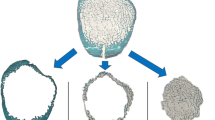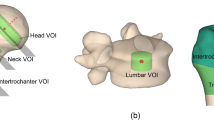Abstract
Age-related expansion of the external surface of the femoral neck in order to offset generalized bone loss is potentially an important mechanism whereby hip strength and hence resistance to hip fracture is maintained. However, it has been widely assumed that bone formation is precluded from this external interface due to the presence of a synovial membrane associated with the hip joint. In this study we have demonstrated histologically that bone formation does indeed occur on the outer "periosteal" surface of the proximal femoral neck. It was therefore hypothesized that an impairment or reduction in periosteal bone formation might be seen in cases of femoral neck fracture compared with age-matched controls. Qualitative analysis of whole femoral neck samples from female subjects and age- and sex-matched post-mortem controls demonstrated that these groups expressed similar distributions of the bone formation marker, alkaline phosphatase (AP), at the periosteal surface [whole biopsy mean % periosteal AP-positive surface: control=16.0 (range=0.5–43.0), fracture=13.4 (range=1.0–34.6), p=0.44]. In conclusion, despite a wide intersubject variation, bone formation at the femoral neck periosteum is a feature of elderly women even if they have had a hip fracture.



Similar content being viewed by others
References
Bell K, Loveridge N, Power J, Garrahan N, Stanton M, Lunt M, Meggitt B, Reeve J. Structure of the femoral neck in hip fracture: cortical bone loss in the inferoanterior to superoposterior axis. J Bone Miner Res 1999;14:112–20.
Crabtree N, Loveridge N, Parker M, Rushton N, Power J, Bell K, Beck T, Reeve J. Intracapsular hip fracture and the region-specific loss of cortical bone: analysis by peripheral quantitative computed tomography. J Bone Miner Res 2001;16:1318–28.
Garn SM. The earlier gain and later loss of cortical bone in nutritional perspective. Springfield, IL: CC Thomas, 1970.
Bradbeer JN, Zanelli J, Lindsay PC, Pearson J, Reeve J. The relationship between the location of osteoblastic alkaline phosphatase activity and bone formation in human iliac crest bone. J Bone Miner Res 1992;7:905–12.
Bradbeer JN, Lindsay PC, Reeve J. Fluctuation of mineral apposition rate at individual BMUs in human iliac cancellous bone: independent correlations with osteoid width and osteoblastic alkaline phosphatase activity. J Bone Miner Res 1994;9:1679–86.
Bell KL, Loveridge N, Lindsay PC, Lunt M, Garrahan N, Compston JE, Reeve J. Cortical remodelling following suppression of endogenous oestrogen with analogues of gonadotrophin releasing hormone. J Bone Miner Res 1997;12:1231–40.
Bell K, Loveridge N, Power J, Rushton N, Reeve J. Intracapsular hip fracture: increased cortical remodelling in the thinned and porous anterior region of the femoral neck. Osteoporos Int 1999;10:248–57.
Stevens A, Bancroft JD. Proteins and nucleic acids. In: Theory and practice of histological techniqes, 2nd ed. Edinburgh: Churchill Livingstone, 1982:145-54.
Parfitt AM, Chir MB, Richmond Smith as a clinical investigator. His work on adult periosteal bone expansion and nutritional and endocrine aspects of osteoporosis in light of current concepts. Henry Ford Hosp Med J 1980;28:95–107.
Beck T, Looker A, Ruff C, Sievanen H, Wahner H. Structural trends in the aging femoral neck and proximal shaft: analysis of the Third National Health and Nutrition Survey dual X–ray absorptiometry data. J Bone Miner Res 2000;15:2297–304
Havelka S, Horn V. Joint cartilage tidemark and periosteum: two components of one envelope. Acta Univ Carol Med 1986;32:311–8.
Balena R, Shih MS, Parfitt AM. Bone resorption and formation on the periosteal envelope of the ilium. A histomorphometric study in healthy women. J Bone Miner Res 1992;7:1475–82.
Shih M, Cook M, Spence C, Palnitkar S, McElroy H, Parfitt A. Relationship between bone formation rate and osteoblast surface on different subdivisions of the endosteal envelope in aging and osteoporosis. Bone 1993;14:519–21.
Crabtree NJ, Kroger H, Martin A, Pols HA, Lorenc R, Nijs J, et al. Improving risk assessment: hip geometry, bone mineral distribution and bone strength in hip fracture cases and controls. The EPOS study. Osteoporos Int 2002;13:48–54.
Jordan G, Loveridge N, Bell KL, Power J, Rushton N, Reeve J. Spatial clustering of osteonal remodelling: a cause of focal weakness in the femoral neck cortex in hip fracture. Bone 2000;26:305–13.
Andreassen T, Jorgensen P, Flyvbjerg A, Orskov H, Oxlund H. Growth hormone stimulates bone formation and strength of cortical bone in aged rats. J Bone Miner Res 1995;10:1057–67.
Ovesen J, Moller-Madsen B, Thomsen J, Danscher G, Mosekilde L. The positive effects of zinc on skeletal strength in growing rats. Bone 2001;29:565–70.
Horiuchi K, Amizuka N, Takeshita S, Takamatsu H, Katsuura M, Ozawa H, et al. Identification and characterisation of a novel protein, periostin, with restricted expression to periosteum and periodontal ligament and increased expression by transforming growth factor. J Bone Miner Res 1999;14:1239–49.
Acknowledgements
This work was supported by MRC Programme Grant 9321536 and was presented in part at the 2001 meeting of the European Society for Calcified Tissues.
Author information
Authors and Affiliations
Corresponding author
Rights and permissions
About this article
Cite this article
Power, J., Loveridge, N., Rushton, N. et al. Evidence for bone formation on the external "periosteal" surface of the femoral neck: a comparison of intracapsular hip fracture cases and controls. Osteoporos Int 14, 141–145 (2003). https://doi.org/10.1007/s00198-002-1333-8
Received:
Accepted:
Published:
Issue Date:
DOI: https://doi.org/10.1007/s00198-002-1333-8




